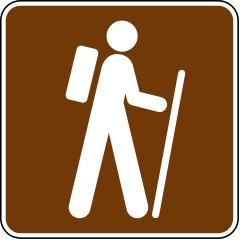
At a Glance
Adventure Type:Hike
Surface: Paved/Asphalt
Length: 11mi
Difficulty: easy
Elevation: 351ft
Trail Type: out and back
Trail Map: Trail_map
Return Time: 3:30pm
Meet Time: 9:15am
Est Cost: 0
Health form parts: AB
Location: Gladstone Community Center, Oregon
Location Website: Gladstone Community Center
Note: might not be the best first hike for a scout. Also, not great for couch potatoes.
Trolly Trail from Gladstone - 11mi
Head out on this 11.0-mile out-and-back trail near Gladstone, Oregon. Generally considered an easy route, it takes an average of 3 h 29 min to complete. This is a popular trail for road biking, running, and walking, but you can still enjoy some solitude during quieter times of day. The trail is open year-round and is beautiful to visit anytime.
Guide to Safe Scouting
Adults complete the following:- SAFE Checklist
- Boy Scouts of America Scouter Code of Conduct
- Youth Protection and Adult Leadership
- Activity Planning and Risk Assessment
- Sports and Activities
- Transportation
Shorter pre-hikes, endurance training
How are we going to prep?
Shorter pre-hikes, endurance training
What age appropriate modifications can be made?
Plan a 5mi out and back option for younger scouts
Gear
- Day Pack
- 10 Essentials
- Hiking boots
- Hiking Poles
- Camera
Pre-Adventure Skillsets
- Be Prepared
- Buddy System
- First Aid
- Fitness
- Gps
- Leave No Trace
- Map & Compass
- Nature
- Hiking
Sample Agenda
*Bring Sack Lunch & 10 Essentials 9:15 Gather at CCC 9:30 Leave CCC for trailhead 10:00 Arrive at trailhead Prebrief 1st 4b 1st 5a 2nd 3b 2nd 4 10:15 Begin hike 12:00 Lunch 1:00 Continue hiking 2:45 Arrive back at trailhead Debrief 2nd 3b 2nd 4 1st 4b 1st 5a 3:00 Leave for CCC 3:30 Arrive at CCC Homework: Hiking MB:5
Rank Requirements
key: At Meeting / On Adventure
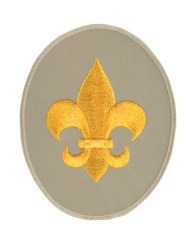
Scout
1e. Repeat from memory the Outdoor Code. List the Leave No Trace Seven Principles. Explain the difference between the two.
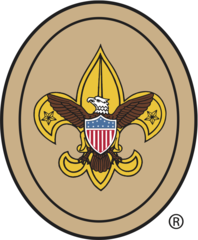
Tenderfoot
1c. Explain how you demonstrated the Outdoor Code and Leave No Trace on campouts or outings.
4a. Show first aid for the following: Simple cuts and scrapes, Blisters on the hand and foot, Minor (thermal/heat) burns or scalds (superficial, or first-degree), Bites or stings of insects and ticks, Venomous snakebite, Nosebleed, Frostbite and sunburn, Choking
5a. Explain the importance of the buddy system as it relates to your personal safety on outings and where you live. Use the buddy system while on a troop or patrol outing.
5b. Describe what to do if you become lost on a hike or campout.
5c. Explain the rules of safe and responsible hiking, both on the highway and cross-country, during the day and at night.
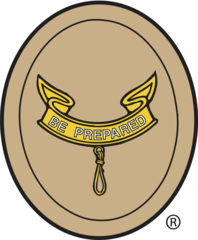
Second Class
1b. Recite the Leave No Trace Seven Principles from memory. Explain how you follow them on all outings.
3a. Demonstrate how a compass works and how to orient a map. Use a map to point out and tell the meaning of five map symbols.
3b. Using a compass and map together, take a 5-mile hike (or 10 miles by bike) approved by your adult leader and your parent or guardian.2
3c. Describe some hazards or injuries that you might encounter on your hike and what you can do to help prevent them
4. Identify or show evidence of at least 10 kinds of wild animals (such as birds, mammals, reptiles, fish, or mollusks) found in your local area or camping location. You may show evidence by tracks, signs, or photographs you have taken.

First Class
4b. Demonstrate how to use a handheld GPS unit, GPS app on a smartphone, or other electronic navigation system while on a campout or hike. Use GPS to find your current location, a destination of your choice, and the route you will take to get there. Follow that route to arrive at your destination.
5a. Identify or show evidence of at least 10 kinds of native plants found in your local area or campsite location. You may show evidence by identifying fallen leaves or fallen fruit that you find in the field, or as part of a collection you have made, or by photographs you have taken.
5b. Identify two ways to obtain a weather forecast for an upcoming activity. Explain why weather forecasts are important when planning for an event.
5c. Describe at least three natural indicators of impending hazardous weather, the potential dangerous events that might result from such weather conditions, and the appropriate actions to take.
5d. Describe extreme weather conditions you might encounter in the outdoors in your local geographic area. Discuss how you would determine ahead of time the potential risk of these types of weather dangers, alternative planning considerations to avoid such risks, and how you would prepare for and respond to those weather conditions.
Awards
key: At Meeting / On Adventure

Outdoor Ethics
1. Recite from memory and explain the meaning of the Outdoor Code.
2. Watch the National Park Service (NPS) Leave No Trace program video. Find the link at www.scouting.org/OutdoorProgram/OutdoorEthics/Awards.aspx.
3. Complete the Leave No Trace online course and print the certificate. Find the link at www.scouting.org/OutdoorProgram/OutdoorEthics/Awards.aspx.
4. Complete the Tread Lightly! online course and print the certificate. Find the link at www.scouting.org/OutdoorProgram/OutdoorEthics/Awards.aspx.
5. Participate in an outdoor ethics course, workshop, or training activity facilitated by a person who has completed the BSA outdoor ethics orientation course or is a BSA outdoor ethics trainer or master.
Merit Badges
key: At Meeting / On Adventure
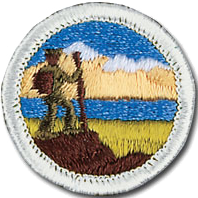
Hiking
1a. Explain to your counselor the most likely hazards you may encounter while hiking, and what you should do to anticipate, help prevent, mitigate, and respond to these hazards.
1b. Show that you know first aid for injuries or illnesses that could occur while hiking, including hypothermia, frostbite, dehydration, heat exhaustion, heatstroke, sunburn, hyperventilation, altitude sickness, sprained ankle, blisters, insect stings, tick bites, and snakebite.
2a. Explain and, where possible, show the points of good hiking practices including proper outdoor ethics, hiking safety in the daytime and at night, courtesy to others, choice of footwear, and proper care of feet and footwear.
2b. Read aloud or recite the Leave No Trace guidelines, and discuss why each is important while hiking.
2c. Read aloud or recite the Outdoor Code, and give examples of how to follow it on a hike
3. Explain how hiking is an aerobic activity. Develop a plan for conditioning yourself for 10-mile hikes, and describe how you will increase your fitness for longer hikes.
4. Take four 10-mile hikes and one 20-mile hike, each on a different day, and each of continuous miles. Prepare a written hike plan before each hike and share it with your merit badge counselor or a designee for approval before starting the hike. Include map routes, a clothing and equipment list, and a list of items for a trail lunch. You may stop for as many short rest periods as needed, as well as one meal, during each hike, but not for an extended period such as overnight.*
5. After each of the hikes (or during each hike if on one continuous trek) in requirement 4, write a short report on your hike. For each hike, give the date and description (or map) of the route covered, the weather, any interesting things you saw, and any challenges you had and how you overcame them. It may include something you learned about yourself, about the outdoors, or about others you were hiking with. Share this with your merit badge counselor.*
Flier
www.Sherwood116.com
Troop 116
Hike @ Trolly Trail from Gladstone - 11miHead out on this 11.0-mile out-and-back trail near Gladstone, Oregon. Generally considered an easy route, it takes an average of 3 h 29 min to complete. This is a popular trail for road biking, running, and walking, but you can still enjoy some solitude during quieter times of day. The trail is open year-round and is beautiful to visit anytime.

Hike!
Trolly Trail from Gladstone - 11mi
Gladstone, Oregon
Gladstone, Oregon

9:15am - 3:30pm

meet at Cedar Creek Church on < date > @ 9:15am

Whole Troop!
We’ll meet at Cedar Creek Church @ 9:15am and carpool to Trolly Trail from Gladstone - 11mi in Gladstone, Oregon.
Gear
- Day Pack
- 10 Essentials
- Hiking boots
- Hiking Poles
- Camera
Skills
- Be prepared
- Buddy System
- First aid
- Fitness
- GPS
- Leave no trace
- Map & Compass
- Nature
- hiking

Make sure to register on troopmaster,
look for the link in your email!!!
look for the link in your email!!!



Troop 116
T-Program Planningfor Campout
Prior to T-5, the PLC should have determined (and dates below):
Outing Event:________________________
Event Date:_______________
Location: ___________________________
Scout in charge: ______________________
QR Code/URL for drive
Itinerary:
Special activities and equipment needed for the outing:
T-5 Date:_______________
- Patrol Leaders hand out event flyers and permission slips and get a straw count.
- Patrol Leaders assign Grubmasters and Assistant Grubmasters (based on advancement
- needs).
- Patrols plan their camp activities.
T-4 Date:_______________
- (PLC assigns SPL and PL’s in charge of outing, SM/ASM’s identify the tour leader.)
- Scouts return permission slips and trip fees to their Patrol Leaders.
- Grubmasters presents menus, make necessary changes, and get SPL/ASM approvals.
- Patrols discuss activity materials and assign Scouts responsible for acquiring materials.
- Patrols plan campfire skits and songs.
T-3 Date:_______________
- Grubmasters assign duty roster responsibilities within their patrols.
- Patrols assign/select tent partners.
- Patrols discuss gear needs and who brings what. Patrol Quartermaster makes gear list
T-2 Date:_______________
- Patrols finalize activity and campfire plans – get SPL/ASM approval.
- Patrols finalize gear and equipment needs, make arrangements with Troop Quartermaster.
T-1 Date:_______________
- Patrols check out tents and other camping gear.
- Grubmasters check out necessary cooking gear.
- Grubmasters receive food money from the troop treasurer.
- Patrols discuss free-time activities.
- Troop Gear Check
T+1 Date:_______________
- Patrols and Grubmasters check in gear and inventory sheets.
- Patrols complete event evaluation.
Week 1

Month's Theme: Hike
Topic: ________________
Date: _____________
Topic: ________________
Date: _____________

Activity
Description
Run By
Time
Pre-opening Activity
Opening Ceremony
- - Flag presentation
- - Oath and Law
- - Uniform inspection
Group Instruction
- - Leave No Trace
Skills Instruction
Scout - Tenderfoot
Scout - Tenderfoot
-

1e. Repeat from memory the Outdoor Code. List the Leave No Trace Seven Principles. Explain the difference between the two. [Leave No Trace]
-

1c. Explain how you demonstrated the Outdoor Code and Leave No Trace on campouts or outings. [Leave No Trace]
2nd - 1st
-

1b. Recite the Leave No Trace Seven Principles from memory. Explain how you follow them on all outings. [Leave No Trace]
Merit Badge
-

2b. Read aloud or recite the Leave No Trace guidelines, and discuss why each is important while hiking. [Leave No Trace]
-
2c. Read aloud or recite the Outdoor Code, and give examples of how to follow it on a hike [Leave No Trace]
Patrol Breakouts
- - T-Minus activities (Duty roster/Menu/etc)
- - Patrol outing planning
- - Advancement check-in (see how advancement is going and what is needed -> report to SPL)
- - (Seasonal planning) Summer camp activities, APC Ideas
Game
Closing
- - Closing Flags
- - Announcements
- - SM’s minute
Total 90 minutes of meeting
After the meeting
Leadership team reviews plans for the next meeting and for the main event.
Week 2

Month's Theme: Hike
Topic: ________________
Date: _____________
Topic: ________________
Date: _____________

Activity
Description
Run By
Time
Pre-opening Activity
Opening Ceremony
- - Flag presentation
- - Oath and Law
- - Uniform inspection
Group Instruction
- - First Aid
- - Map & Compass
- - Fitness
Skills Instruction
Scout - Tenderfoot
Scout - Tenderfoot
-

4a. Show first aid for the following: Simple cuts and scrapes, Blisters on the hand and foot, Minor (thermal/heat) burns or scalds (superficial, or first-degree), Bites or stings of insects and ticks, Venomous snakebite, Nosebleed, Frostbite and sunburn, Choking [First Aid]
2nd - 1st
-

3a. Demonstrate how a compass works and how to orient a map. Use a map to point out and tell the meaning of five map symbols. [Map & Compass]
-
3c. Describe some hazards or injuries that you might encounter on your hike and what you can do to help prevent them [First Aid]
Merit Badge
-

1b. Show that you know first aid for injuries or illnesses that could occur while hiking, including hypothermia, frostbite, dehydration, heat exhaustion, heatstroke, sunburn, hyperventilation, altitude sickness, sprained ankle, blisters, ins... [First Aid]
-
3. Explain how hiking is an aerobic activity. Develop a plan for conditioning yourself for 10-mile hikes, and describe how you will increase your fitness for longer hikes. [Fitness]
Patrol Breakouts
- - T-Minus activities (Duty roster/Menu/etc)
- - Patrol outing planning
- - Advancement check-in (see how advancement is going and what is needed -> report to SPL)
- - (Seasonal planning) Summer camp activities, APC Ideas
Game
Closing
- - Closing Flags
- - Announcements
- - SM’s minute
Total 90 minutes of meeting
After the meeting
Leadership team reviews plans for the next meeting and for the main event.
Week 3

Month's Theme: Hike
Topic: ________________
Date: _____________
Topic: ________________
Date: _____________

Activity
Description
Run By
Time
Pre-opening Activity
Opening Ceremony
- - Flag presentation
- - Oath and Law
- - Uniform inspection
Group Instruction
- - Buddy System
- - Hiking
- - Nature
Skills Instruction
Scout - Tenderfoot
Scout - Tenderfoot
-

5a. Explain the importance of the buddy system as it relates to your personal safety on outings and where you live. Use the buddy system while on a troop or patrol outing. [Buddy System]
-
5c. Explain the rules of safe and responsible hiking, both on the highway and cross-country, during the day and at night. [Hiking]
2nd - 1st
-

5b. Identify two ways to obtain a weather forecast for an upcoming activity. Explain why weather forecasts are important when planning for an event. [Nature]
-
5c. Describe at least three natural indicators of impending hazardous weather, the potential dangerous events that might result from such weather conditions, and the appropriate actions to take. [Nature]
-
5d. Describe extreme weather conditions you might encounter in the outdoors in your local geographic area. Discuss how you would determine ahead of time the potential risk of these types of weather dangers, alternative planning considerations to avoid such risks, and how you would prepare for and respond to those weather conditions. [Nature]
Merit Badge
-

1a. Explain to your counselor the most likely hazards you may encounter while hiking, and what you should do to anticipate, help prevent, mitigate, and respond to these hazards. [Nature]
-
2a. Explain and, where possible, show the points of good hiking practices including proper outdoor ethics, hiking safety in the daytime and at night, courtesy to others, choice of footwear, and proper care of feet and footwear. [Hiking]
Patrol Breakouts
- - T-Minus activities (Duty roster/Menu/etc)
- - Patrol outing planning
- - Advancement check-in (see how advancement is going and what is needed -> report to SPL)
- - (Seasonal planning) Summer camp activities, APC Ideas
Game
Closing
- - Closing Flags
- - Announcements
- - SM’s minute
Total 90 minutes of meeting
After the meeting
Leadership team reviews plans for the next meeting and for the main event.
Week 4

Month's Theme: Hike
Topic: ________________
Date: _____________
Topic: ________________
Date: _____________

Activity
Description
Run By
Time
Pre-opening Activity
Opening Ceremony
- - Flag presentation
- - Oath and Law
- - Uniform inspection
Group Instruction
- - Be Prepared
Skills Instruction
Scout - Tenderfoot
Scout - Tenderfoot
-

5b. Describe what to do if you become lost on a hike or campout. [Be Prepared]
2nd - 1st
Merit Badge
Patrol Breakouts
- - T-Minus activities (Duty roster/Menu/etc)
- - Patrol outing planning
- - Advancement check-in (see how advancement is going and what is needed -> report to SPL)
- - (Seasonal planning) Summer camp activities, APC Ideas
Game
Closing
- - Closing Flags
- - Announcements
- - SM’s minute
Total 90 minutes of meeting
After the meeting
Leadership team reviews plans for the next meeting and for the main event.